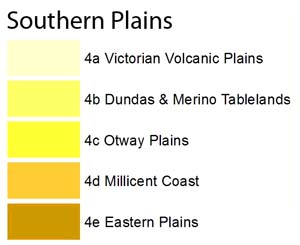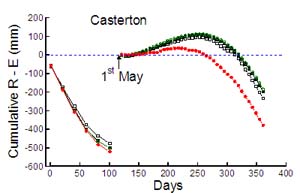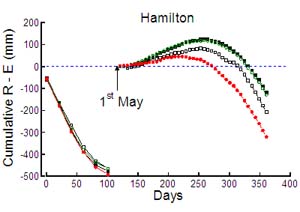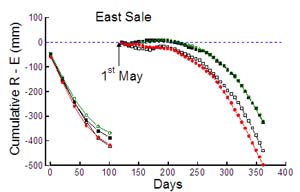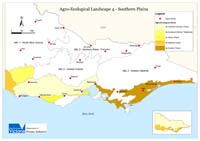Primary Production Landscapes Home | Southern Plains Home
Land use
Covering 51 local government areas and 6 catchment management authority regions, the major land use of the Southern Plains is production from dryland agriculture cropping, grazing and dairy) and forestry (77%). New blue gum forestry plantings are estimated to be 10,000 – 14,000 hectares per year. This has moderated since 8-10 years ago. Irrigated agriculture (8%) and intensive uses including horticulture and animal production (36% of Victoria’s land use) occur also. Rainfall varies from 450 mm west of Melbourne to 1100 mm at the foothills of the Southern Uplands. | |
Primary Production Landscapes
Victorian Volcanic Plains
Volcanic cones, lava flows and ash deposits are used mainly for grazing and cropping. Rainfall is higher and evaporation less than plains north of the divide.
Dundas & Merino Tablelands
The deeply dissected and weathered terrain has traditionally been used for grazing. Constraints to plant growth include soils with low pH and iron gravels that limit access to soil moisture.
Otway Plains
Rainfall within the plains is quite variable and the terrain diverse. Waterlogging is a major production constraint for prominent land uses including dairy and forestry.
Millicent Coast
Siliceous and calcareous plains and dunes are mainly used for dairy, forestry and fodder production. Soils and landforms continue into South Australia where viticulture also occurs.
Eastern Plains
Extensive alluvial systems from erosion of the Eastern Uplands generally receive higher rainfall and less evaporation than plains in the west. Grazing, forestry and dairy are main land uses on gradational and texture contrast soils. |
|
Management practices and issues in response to Climate Change
- Global commodity prices are high and world demand is increasing for grains. Prices in Victoria tend to increase as harvest continues from north to south. Most farmers are operating 70% grains, 30% livestock.
- Climate change impacts to management practices include:
- Waterlogged soils that were a major constraint have produced good crops.
- Runoff has decreased along with water flows into storages.
- Harvesting crops was a significant issue, dry conditions have alleviated problems.
- Grain quality impacts from severe frosts have been experienced (2006).
- Dry seasons have favoured plantings of lucerne and continued drying of soil profiles.
- Operation window for cropping has increased, allowing greater management flexibility.
- Tight finishes to the growing season are experienced due to shortages of available soil moisture.
- Cropping of land to adapt for feed shortages is occurring (e.g. red gum plains in East Gippsland).
- Crop yields are increasing along with land used for grains production.
- Move away from burning stubbles to trash retention and no-till farming systems.
- Tilling of land mainly used for degraded pastures in raised bed making and on previously uncropped land. Drier seasons have meant reduced tillage practices (movement towards minimum tillage and no-till systems) are more appealing then conventional practices to improve soil moisture retention.
- Latest technological advances and changes to management practices include:
- Access to improved cropping and livestock handing equipment.
- Modernisation of raised bed cropping practices.
- Control Traffic Farming (CTF) is increasing in frequency.
- Usage of contractors with latest machinery is widely accepted.
- Larger farms, therefore greater efficiencies in production are occurring.
- Perceived costs of precision agriculture have had a negative impact on adoption.
- Changes in sowing practices include press wheels and knife points.
- Land resource pressures from dairy in the south and horticulture land uses between Geelong and Melbourne.
- Crop rotations occur on a 3-4 year cycle (C, W, B, B/O) that may be continuous (except if weed issues exist). Currently a good legume to use (except canola as a break crop) for fixing nitrogen isn’t available. A reliance on lucerne has occurred in response to no legumes fitting current crop rotations.
- Approaches to maximise efficiencies and productivities of mixed farming systems including finishing prime lambs are developing.
- Diversity and usage of herbicides has increased significantly. Pesticide usage has decreased in response to seed treatments and integrated pest management approaches.
- Increased focus on soil health and understanding soil moisture availability.
- Climate change has been viewed positively with mixed farming systems continuing to adapt.
|
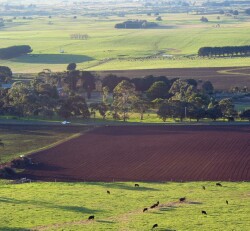
Cropping at Alvie

Canola cropping |
Future scenarios for farming systems
- Further integration of lucerne into rotations to prosper from available deep soil moisture.
- Continued uptake of grains and decline in other production systems. There could be a potential shift back to pastures if input prices keep increasing without grain increasing proportionally.
- Reduced reliance on fertilisers and increased use of bi-products in farming for nutrients.
- Expectation that global commodity and input prices will remain high.
- Selection of shorter growing season varieties (potential for pulses) to reflect climatic changes.
- Considered to be highly promising farm production systems with yields predicted to increase.
- Access to contractors to remain satisfactory for industry expansion.
| 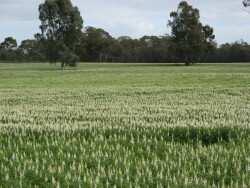
Lupin cropping |
Victoria’s changing climate
Mean annual temperature (two scenarios from past records and one predicted scenario)
1970-1995 | 1996-2005 | 2050 A1FI prediction |
| | |
|
1970-1995 | 1996-2005 | 2050 A1FI prediction |
| | |
|
